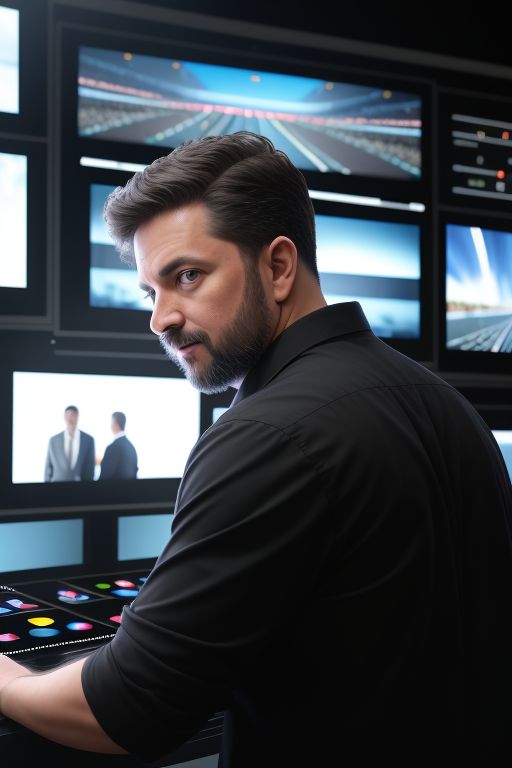The Graphics Operator plays a crucial role in enhancing the visual appeal and informational content of a program. This professional is responsible for creating, managing, and displaying graphical elements that support the storytelling and branding of the broadcast. These elements can include lower thirds, full-screen graphics, animations, and other visual enhancements. This article delves into the diverse responsibilities of a Graphics Operator, highlighting their significance, required skills, and the impact they have on the overall production.
The Role of a Graphics Operator in Broadcast
The Graphics Operator is tasked with designing and implementing graphic content that complements the broadcast. They work closely with directors, producers, and other technical staff to ensure that all graphical elements are integrated smoothly and effectively. Here’s a detailed look at their key responsibilities:
- Pre-Production Planning
- Design Concept Development: The Graphics Operator collaborates with the production team to develop the visual style and design concepts for the broadcast. This includes determining the types of graphics needed and how they will be used.
- Graphics Preparation: They create all necessary graphic elements before the production begins. This includes designing lower thirds, full-screen graphics, animations, and any other visual content required for the broadcast.
- Software Setup: The Graphics Operator sets up and tests the graphics software and hardware to ensure that everything is functioning correctly. They prepare templates and load all graphics into the system.
- Production Execution
- Live Graphics Operation: During the broadcast, the Graphics Operator is responsible for displaying graphical elements in real-time. They follow a rundown and cues from the director to ensure that graphics appear at the right moments.
- Coordination with Crew: The Graphics Operator works closely with the director, technical director, and other crew members to ensure that graphics are integrated seamlessly into the broadcast. This requires clear communication and precise timing.
- Real-Time Adjustments: They must be able to make real-time adjustments to graphics as needed. This includes updating information, correcting errors, and adapting to changes in the production plan.
- Post-Production Support
- Graphics Review: After the broadcast, the Graphics Operator reviews the graphics to ensure that they met the desired quality standards. They gather feedback from the production team and make notes for future improvements.
- Maintenance and Updates: They maintain and update the graphics library, ensuring that all elements are organized and ready for future use. This includes backing up files and updating software as needed.
Key Skills Required for a Graphics Operator
Being an effective Graphics Operator requires a combination of technical proficiency, creative skills, and attention to detail. Here are some of the most critical skills needed:
- Graphic Design: Graphics Operators must have strong graphic design skills and proficiency in design software such as Adobe Creative Suite (Photoshop, Illustrator, After Effects) and specialized broadcast graphics software.
- Technical Knowledge: They need to understand the technical aspects of broadcasting graphics, including how to operate graphics systems and integrate them into the broadcast workflow.
- Creativity: A creative eye for design is essential to create visually appealing and effective graphics that enhance the broadcast.
- Attention to Detail: Precision and attention to detail are crucial to ensure that all graphics are accurate, clear, and professionally presented.
- Communication: Effective communication with the production team and other crew members is vital for ensuring that all tasks are carried out smoothly.
The Impact of a Graphics Operator
The Graphics Operator’s role is central to the overall visual appeal and effectiveness of a broadcast. Their work directly influences the viewer’s experience and the production’s ability to convey information clearly and engagingly. Here are some ways Graphics Operators make a significant impact:
- Visual Appeal: By creating high-quality graphics, Graphics Operators enhance the overall visual appeal of the broadcast, making it more engaging and professional.
- Information Clarity: They ensure that all informational graphics, such as lower thirds and full-screen graphics, are clear and easy to read, contributing to a seamless viewing experience.
- Branding Consistency: Graphics Operators help maintain consistency in branding by ensuring that all graphical elements align with the production’s visual style and brand guidelines.
- Support for Storytelling: By integrating graphics effectively, they support the storytelling and enhance the narrative, making complex information easier to understand.
The Graphics Operator’s Workflow in Broadcast Production
To understand the role of a Graphics Operator, it’s essential to look at their workflow in detail, from pre-production to post-production.
- Pre-Production Phase
- Concept Development: The Graphics Operator collaborates with the production team to develop the visual style and design concepts for the broadcast. They determine the types of graphics needed and plan how they will be used.
- Graphics Creation: They create all necessary graphic elements, including lower thirds, full-screen graphics, animations, and any other visual content required for the broadcast.
- Software Setup: The Graphics Operator sets up and tests the graphics software and hardware, preparing templates and loading all graphics into the system to ensure everything functions correctly.
- Production Phase
- Live Graphics Operation: During the broadcast, the Graphics Operator displays graphical elements in real-time, following cues from the director to ensure that graphics appear at the right moments.
- Coordination: They work closely with the director, technical director, and other crew members to ensure seamless integration of graphics into the broadcast. This requires clear communication and precise timing.
- Real-Time Adjustments: The Graphics Operator makes real-time adjustments to graphics as needed, updating information, correcting errors, and adapting to changes in the production plan.
- Post-Production Phase
- Graphics Review: After the broadcast, the Graphics Operator reviews the graphics to ensure they met the desired quality standards. They gather feedback from the production team and make notes for future improvements.
- Maintenance: They maintain and update the graphics library, ensuring that all elements are organized and ready for future use. This includes backing up files and updating software as needed.
The Evolution of the Graphics Operator’s Role
The role of the Graphics Operator has evolved significantly with advancements in technology and changes in production methods. Today’s Graphics Operators must stay updated with the latest tools and techniques in the industry:
- Advanced Graphics Software: The use of advanced graphics software and real-time rendering tools has expanded the capabilities of Graphics Operators, allowing for more complex and dynamic graphics.
- 3D Graphics and Animation: The incorporation of 3D graphics and animation has added new dimensions to broadcast graphics, requiring Graphics Operators to be proficient in 3D design and animation software.
- Interactive Graphics: The rise of interactive graphics and augmented reality elements has expanded the role of Graphics Operators, requiring them to integrate interactive elements into live broadcasts.
- Multi-Platform Integration: With the growth of digital and social media platforms, Graphics Operators must consider how graphics will appear across various platforms, ensuring consistency and quality.
Real-World Examples of Graphics Operators
To illustrate the impact and responsibilities of Graphics Operators, let’s look at some real-world examples:
- Live Sports Broadcasting
- Graphics Operator’s Role: In live sports broadcasting, the Graphics Operator creates and manages graphics such as scoreboards, player statistics, and instant replays. They ensure that all graphics are displayed in real-time and enhance the viewer’s understanding of the game.
- Challenges: Live sports require quick decision-making and precise timing to ensure that graphics are displayed accurately and promptly. The Graphics Operator must be able to adapt to changes in the game and provide real-time updates.
- News Broadcasting
- Graphics Operator’s Role: In news broadcasting, the Graphics Operator designs and displays graphics such as lower thirds, full-screen graphics, and breaking news alerts. They ensure that all graphics are clear, accurate, and support the storytelling.
- Challenges: News broadcasts often involve rapidly changing information, requiring the Graphics Operator to update graphics quickly and ensure that they are accurate and up-to-date.
- Television Shows
- Graphics Operator’s Role: For television shows, the Graphics Operator creates and manages graphics that enhance the visual storytelling. This includes opening titles, lower thirds, and any other visual elements that support the narrative.
- Challenges: Television productions often involve complex graphics and animations, requiring the Graphics Operator to ensure that all elements are seamlessly integrated and enhance the viewer’s experience.
Conclusion
The role of a Graphics Operator in broadcast is multifaceted and essential to the success of any production. Graphics Operators are the visual experts who create and manage graphical elements that enhance the broadcast’s visual appeal and informational content. Their responsibilities span creative, technical, and collaborative tasks, requiring a unique blend of skills and expertise.
Graphics Operators play a crucial role in ensuring high-quality visual content, contributing significantly to the overall impact and success of the broadcast. Their work enhances the narrative, engages the audience, and ensures that the production runs smoothly and efficiently.





